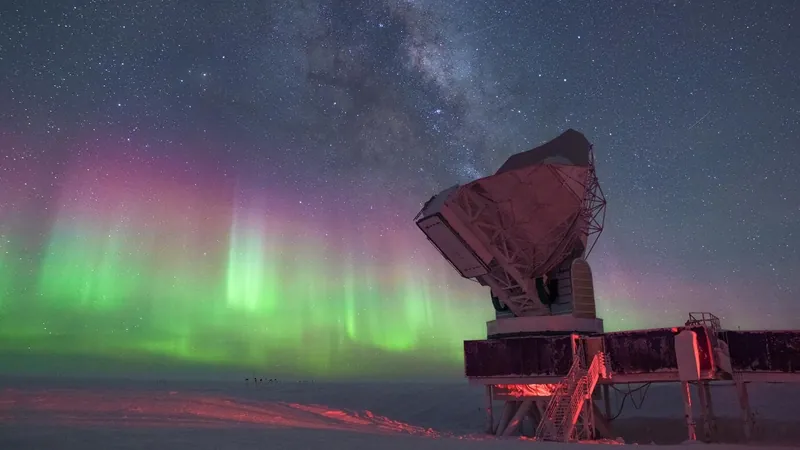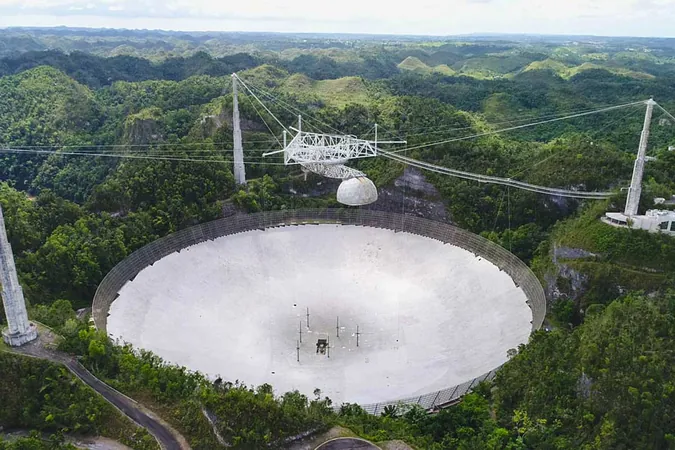
Groundbreaking Study from the South Pole Telescope Sheds Light on the Universe’s Expansion
2024-11-14
Author: Olivia
Unveiling the Cosmic Microwave Background
In an awe-inspiring journey through time, scientists are uncovering the secrets of the universe, stemming all the way back to a mere 400,000 years after the cataclysmic Big Bang. During this primordial moment, the universe cooled just enough for photons, the universe's first light, to break free from a dense cosmic mist, resulting in what we now know as the Cosmic Microwave Background (CMB).
A New Study from the South Pole Telescope
A recent study utilizing data gathered by the South Pole Telescope, located at the National Science Foundation's Amundsen-Scott South Pole Station in Antarctica, aims to delve deeper into understanding the foundational aspects of the standard cosmological model which has successfully narrated the universe's evolution over the last 14 billion years. The research, spearheaded by a team from UC Davis, alongside the South Pole Telescope collaboration led by the University of Chicago, has been submitted to Physical Review D and is currently accessible via the arXiv preprint server.
This cutting-edge research provides high-precision measurements of the CMB and its polarized light—evidence supporting the reliability of the standard cosmological model. Notably, it presents a fresh calculation of the Hubble constant, which measures how quickly the universe is expanding, offering new perspectives on the perplexing astronomical conundrum dubbed 'the Hubble tension.'
“We have a largely coherent, detailed, and successful model describing these 14 billion years of evolution,” remarked Lloyd Knox, a noted cosmologist at UC Davis and one of the study's co-authors. “However, the origins of the initial irregularities that cultivated the universe's structures—including our existence—remain a mystery.”
Tom Crawford, a research professor at the University of Chicago, emphasized the significance of their findings, stating, “This result is particularly thrilling, as it represents the first competitive constraints on cosmology derived solely from the polarization of the CMB, rendering it nearly 100% independent of prior results that are largely intensity-driven.”
Unlocking the Universe with Polarized Light
The study meticulously examined two years of polarized light data collected by the South Pole Telescope during 2019 and 2020. Researchers analyzed 1,500 square degrees of sky, crafting a comprehensive map of the universe's mass distribution.
Light normally oscillates freely, but when it reflects off a surface, such as water, it can become polarized—oscillating in a preferred direction, much like the glare reduced by polarized sunglasses. This phenomenon also occurred during the final scattering events of CMB photons.
“Our task involves measuring the polarization at different points on our sky map,” Knox elaborated, observing that this polarized light traveled across space only to be subtly distorted by gravitational forces—leading to a warped cosmic image known as gravitational lensing.
To comprehend the interplay between polarized data and gravitational lensing effects, the researchers relied on the powerful supercomputers at the National Energy Research Scientific Computing Center (NERSC) in Berkeley, California. “Our team sends the data to this supercomputer, testing whether proposed models of the universe produce maps that correspond to our observations,” explained Marius Millea, a prominent project scientist.
Deciphering the Hubble Tension
A critical aspect of their research focuses on the well-known 'Hubble tension,' an ongoing debate among cosmologists regarding the varying rates of the universe’s expansion. Some methodologies suggest a more accelerated expansion than others—leaving scientists at a crossroads with no consensus.
One common method estimates expansion using the standard cosmological model in conjunction with CMB observations. In contrast, another relies on direct measurements from stars and supernovae, which frequently indicate a higher rate of expansion. This discrepancy poses one of the most significant hurdles in modern cosmology.
By integrating their findings on polarization with the standard cosmological model, the team generated a new prediction for the universe's expansion rate, aligning closely with measurements derived from CMB intensity maps obtained by the European Space Agency’s Planck satellite, while simultaneously highlighting significant differences when compared to supernova measurements.
As the scientific community continues to grapple with bewildering questions, this groundbreaking research adds essential pieces to the intricate puzzle of our universe. Scientists are excited to see how these revelations will transform our understanding of cosmic history and the fundamental forces shaping our reality. Stay tuned for more updates as new discoveries unfold!









 Brasil (PT)
Brasil (PT)
 Canada (EN)
Canada (EN)
 Chile (ES)
Chile (ES)
 España (ES)
España (ES)
 France (FR)
France (FR)
 Hong Kong (EN)
Hong Kong (EN)
 Italia (IT)
Italia (IT)
 日本 (JA)
日本 (JA)
 Magyarország (HU)
Magyarország (HU)
 Norge (NO)
Norge (NO)
 Polska (PL)
Polska (PL)
 Schweiz (DE)
Schweiz (DE)
 Singapore (EN)
Singapore (EN)
 Sverige (SV)
Sverige (SV)
 Suomi (FI)
Suomi (FI)
 Türkiye (TR)
Türkiye (TR)